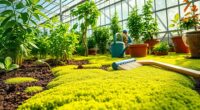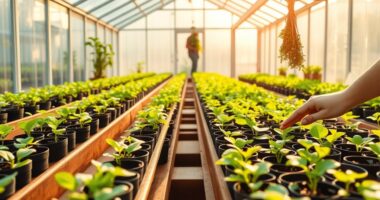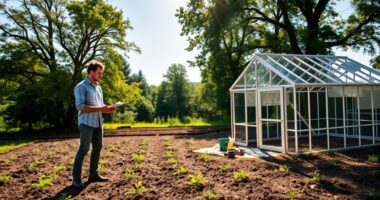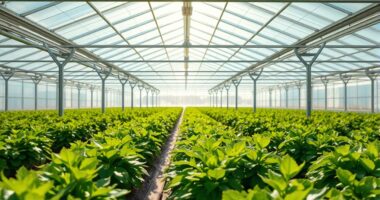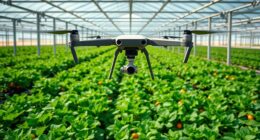Understanding greenhouse climate control is key to maximizing your plants’ growth and yield. You need to monitor temperature, humidity, and light to create the best environment. Effective temperature control minimizes stress, while managing humidity levels keeps plants healthy. Using efficient lighting solutions helps plants photosynthesize better. Good ventilation guarantees fresh air circulation, and incorporating energy-efficient practices cuts costs. By mastering these elements, you can boost productivity and sustainability in your greenhouse setup. Explore further for deeper insights.
Key Takeaways
- Maintaining optimal temperatures between 64-75 ºF is crucial for crop health and yield, requiring effective heating and cooling systems.
- Humidity control involves techniques like ventilation, mechanical dehumidifiers, and misting systems to ensure healthy plant growth.
- Implementing energy-efficient lighting solutions, such as LED grow lights and High Pressure Sodium fixtures, enhances plant growth while reducing energy costs.
- Effective ventilation strategies, including automated systems and cross ventilation, improve air circulation and maintain temperature and humidity levels.
- Utilizing renewable energy sources, like solar panels and geothermal systems, can significantly lower operational costs and enhance sustainability in greenhouse operations.
Importance of Temperature Control
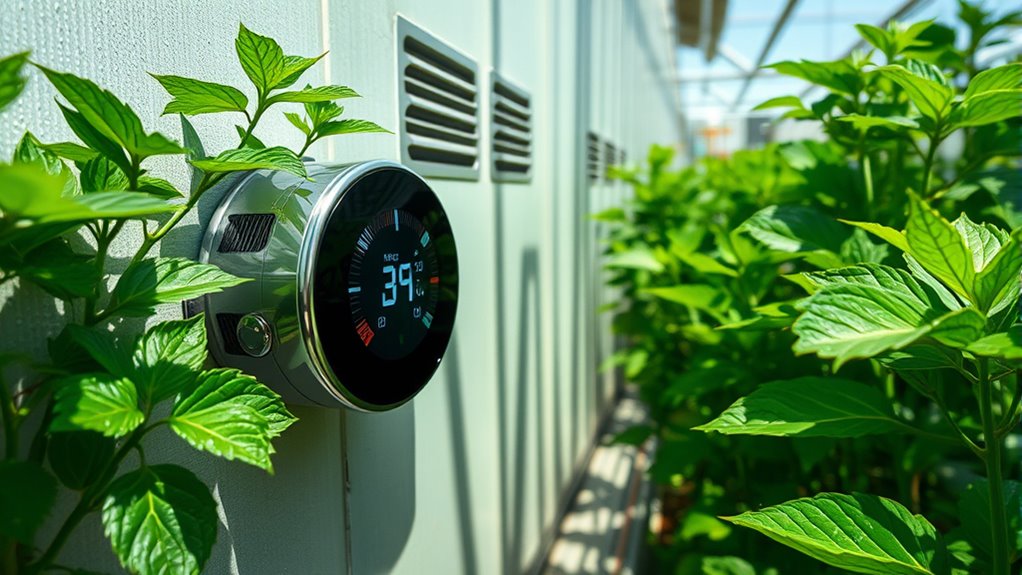
When you’re managing a greenhouse, understanding the importance of temperature control is essential for your crops’ success.
Most crops thrive in a temperature range of 64-75 ºF, which promotes efficient photosynthesis and healthy metabolic processes. Keeping temperatures within this range enhances crop quality and yield by minimizing stress.
You’ll also save energy with effective temperature control systems, like gas boilers or thermal screens, which help maintain warmth while reducing costs.
Remember, seasonal changes require adjustments in your heating and cooling strategies to meet varying temperature needs.
Managing Humidity Levels

Managing humidity levels in your greenhouse is essential for plant health.
You can use dehumidification techniques, like dehumidifiers or ventilation, to keep moisture in check.
Additionally, misting and fogging systems can help you maintain the right humidity when needed.
Dehumidification Techniques
Effective dehumidification techniques are essential for maintaining ideal humidity levels in your greenhouse, which directly impacts plant health and growth.
You can manage humidity by using ventilation systems that replace moist air with drier outdoor air. This method is often more efficient when combined with heating.
Mechanical dehumidifiers also help by cooling and condensing moisture, then reheating the air for recirculation.
Consider chemical dehumidifiers that absorb moisture using desiccant materials, particularly in suitable climates.
Integrating these systems with sensors can optimize humidity control by adapting to changing conditions. Additionally, understanding the importance of humidity control is crucial for achieving robust plant growth in your greenhouse.
Misting and Fogging Systems
To maintain ideal humidity levels in your greenhouse, misting and fogging systems offer practical solutions that cater to different plant needs. Misting systems, while cost-effective, dispense larger droplets that might harm delicate plants. Conversely, fogging systems provide a fine mist, ideal for tropical species, promoting rapid evaporation and cooling.
Here’s a quick comparison of both systems:
| Feature | Misting Systems | Fogging Systems |
|---|---|---|
| Droplet Size | Larger droplets | Fine mist |
| Application | Cooling and humidification | Gentle hydration for delicate plants |
| Cost | Generally less expensive | Higher initial cost, more efficient |
| Energy Efficiency | Moderate | Up to 30% more efficient |
Effective Lighting Solutions
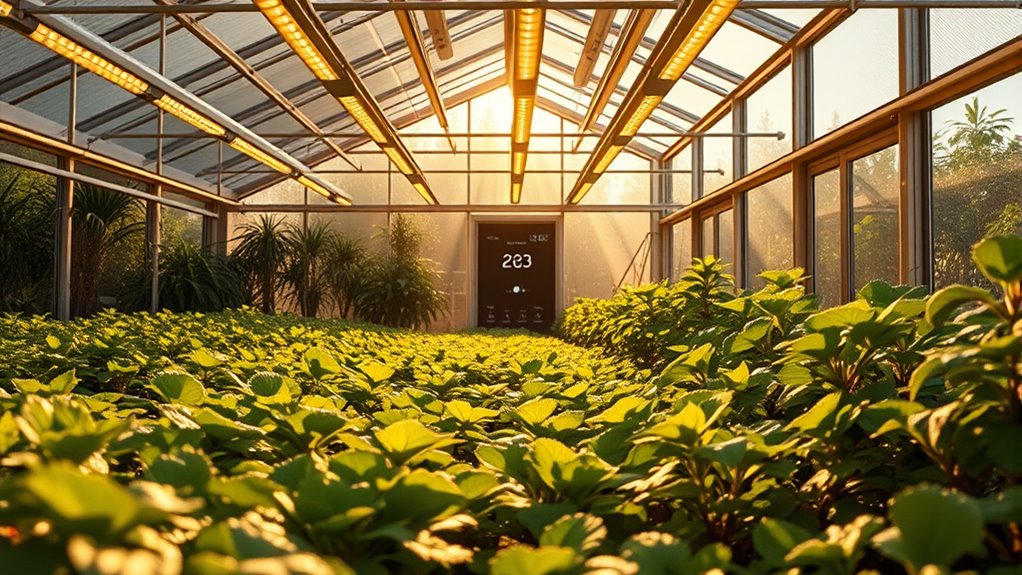
Lighting plays an essential role in greenhouse success, influencing plant growth, yield, and overall quality.
LED grow lights are a great choice for energy efficiency, reduced heat, and customizable spectra to optimize plant growth. If you need intense light for late growth stages, consider High Pressure Sodium fixtures alongside LEDs.
For hydroponics, Ceramic Metal Halide lighting retains the color spectrum while using less energy. T5 fixtures provide a durable, energy-efficient fluorescent option.
You can enhance your setup with smart LED systems that allow real-time adjustments and lighting sensors that automate based on conditions.
Ventilation and Airflow Strategies
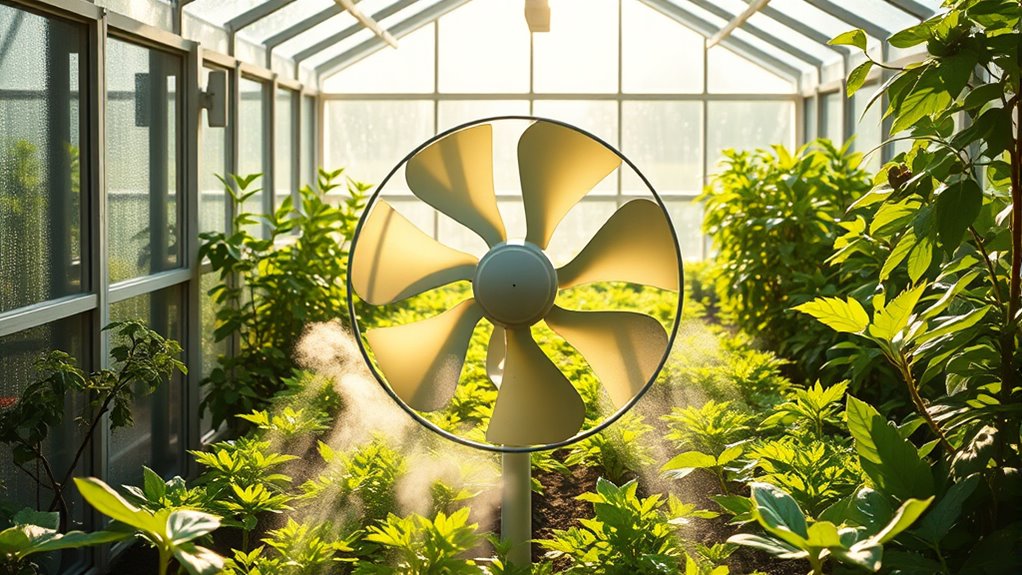
Achieving ideal plant growth isn’t just about lighting; proper ventilation and airflow are equally important.
To guarantee your greenhouse thrives, consider using roof vents to expel hot air and side vents to bring in fresh air. Automated vent systems can monitor temperature and humidity, adjusting as needed.
Implement natural ventilation to reduce energy use, while active ventilation, like exhaust fans, can handle low-wind conditions effectively. Cross ventilation enhances air circulation, so place vents on opposite sides.
Don’t forget adjustable louvers for fine-tuning airflow. By strategically positioning vents and adapting to seasonal changes, you’ll maintain peak temperatures and humidity, preventing diseases and boosting productivity for your plants.
Energy Efficiency in Greenhouse Operations

As greenhouse operators seek to maximize productivity while minimizing costs, energy efficiency becomes an essential factor. You can reduce reliance on fossil fuels by incorporating renewable energy sources like solar panels, wind turbines, and biomass systems.
For sunny areas, solar energy can markedly cut operational costs, while windy regions can benefit from wind turbines. Utilizing geothermal systems can also provide long-term savings.
Implementing energy-efficient technologies like heat pumps, thermal energy storage, and proper insulation minimizes heat loss and improves energy use.
Don’t underestimate the impact of climate control strategies, such as effective temperature and humidity management, which guarantee ideal conditions for plant growth.
These practices not only lower costs but also enhance sustainability, giving you a competitive edge in the market.
The Role of Automation in Climate Control
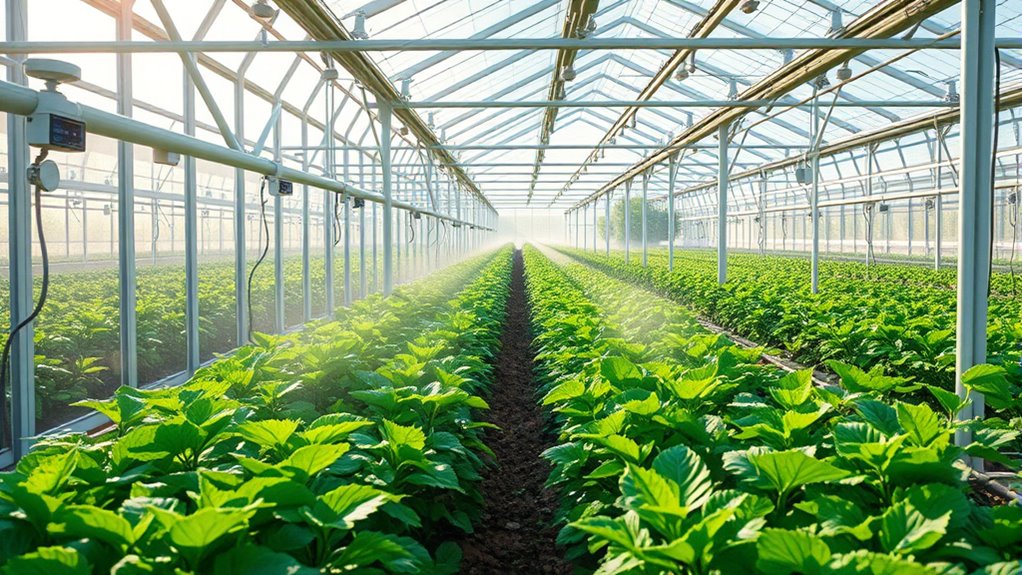
Energy efficiency plays a significant role in greenhouse operations, but it’s automation that truly enhances climate control.
By utilizing advanced technology, automation systems precisely manage temperature, humidity, irrigation, ventilation, and lighting, creating ideal conditions for your crops.
With real-time data collection, you can make informed decisions to improve growth and productivity. Remote monitoring allows you to adjust conditions from anywhere, increasing efficiency and reducing labor costs.
Real-time data empowers informed decisions, while remote monitoring enhances efficiency and cuts labor costs.
Smart controllers and IoT integration guarantee seamless operation, while AI predicts climate changes for proactive adjustments.
Modular designs let you customize systems based on specific crop needs, and user-friendly interfaces simplify management.
Ultimately, automation not only boosts crop quality but also maximizes resources, making your greenhouse operations more sustainable and scalable.
Frequently Asked Questions
How Do I Choose the Right Greenhouse Size for My Plants?
To choose the right greenhouse size for your plants, start by considering the types of plants you want to grow and their mature sizes.
Measure your available space and assess how much room each plant requires.
Think about using vertical growing techniques to maximize space.
If you plan to expand in the future, select a size that accommodates growth.
Don’t forget to check local zoning laws to guarantee compliance with size restrictions.
What Types of Plants Benefit Most From Greenhouse Environments?
Ever wondered why some plants seem to thrive like they’re on a tropical vacation?
In a greenhouse, tomatoes, cucumbers, and strawberries flourish, benefiting from controlled conditions.
You’ll find leafy greens and peppers avoid common pests while enjoying peak growth.
Medicinal plants like mint and aloe vera also thrive, thanks to consistent environments.
With flowers like roses and orchids, you’ll see vibrant blooms year-round.
Greenhouses truly elevate plant health and yield!
How Often Should I Check My Greenhouse Sensors?
You should check your greenhouse sensors at least once a day.
Daily checks guarantee you catch any discrepancies in temperature, humidity, or light levels that could affect your plants. If you notice any significant fluctuations, consider increasing the frequency.
Additionally, regularly calibrating and maintaining your sensors will help keep your readings accurate, ultimately leading to better crop yield and quality.
Consistent monitoring is key to successful greenhouse management.
What Are the Common Issues With Greenhouse Climate Control Systems?
You wouldn’t believe the chaos that can erupt in greenhouse climate control systems!
From blocked air circulation causing humidity nightmares to temperature swings that feel like a rollercoaster, it’s a wild ride.
Insufficient ventilation and inadequate fan placement create uneven conditions, while clogged filters choke airflow.
Not to mention, excessive humidity and inadequate dehumidification can turn your plants into disease magnets.
Keeping a close eye on these issues is essential for thriving greenery!
How Can I Troubleshoot Heating System Failures in My Greenhouse?
To troubleshoot heating system failures in your greenhouse, start with a visual inspection for wear or loose components.
Clean your heater and ductwork regularly to maintain efficiency.
Guarantee proper air circulation and verify that your fuel is clean and compatible with your system.
Check your thermostat settings to confirm they’re accurate.
Keeping a maintenance log can help you track issues and prevent future problems, guaranteeing your heating system runs smoothly.
Conclusion
In the world of greenhouse climate control, mastering temperature, humidity, lighting, ventilation, and energy efficiency isn’t just important—it’s essential. With the right techniques and automation, you can transform your greenhouse into a thriving ecosystem. Think of it as giving your plants a comfortable home where they can flourish. So, why settle for mediocrity when you can harness these strategies to cultivate a lush paradise right in your backyard? Your green thumb deserves it!

